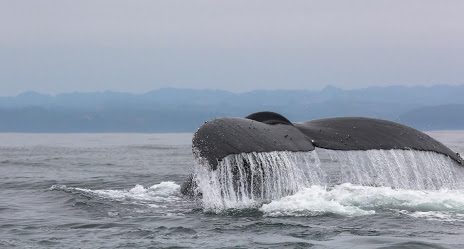From July 26 to August I participated in a Laboratory exchange at the Geospatial Ecology of Marine Megafauna Laboratory (GEMM Lab) at Oregon State University at the Hatfield Marine Science Center (HMSC), Newport-OR. I was hosted by principal investigator (PI) Dr. Leigh Torres with the two main objectives of 1) collaborating and learning non-invasive fieldwork techniques for studying free-range whales and 2) interacting with, exchanging ideas, and networking with the GEMM Lab members. PhD candidate Leila Lemos lead the research specifically titled, “Evaluation of gray whale hormone and body condition variation, with response to variable ambient ocean noise conditions,” a project which aims to evaluate the hormonal variability and health of the gray whales that forage along the Oregon coast.
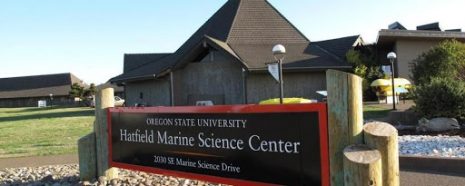
Marine mammals live and have evolved in an acoustic world where the production and reception of sounds plays a fundamental role for survival. Sound intervenes in the biology of cetaceans in numerous ways, from mediating the attraction and selection of mates to the search for prey and the perception of their environment. The human use of the oceans, whether for navigation, military activities, exploration for gas or petroleum resources, and tourist or recreational navigation increases the amount of sounds in the sea. Usually these sounds of anthropic origin do not represent signals for marine fauna and are considered as “noise” that can affect marine animals in different ways. Despite its importance, there is limited knowledge about the physiological stress response to human noise for cetaceans and marine mammals in general. Research into stress physiology of mysticete whales has been hampered by difficulty in obtaining physiological samples from individuals; however, new methods are available for measuring hormone levels in whales and have the potential to improve our understanding of whale physiological condition to target important conservation questions, such as the ones Leila Lemos´ project is undertaking.
Field season for this project expands between May and October each year, and the gray whales, Eschrichtius robustus, subject of this study are part of the Pacific Coast Feeding Group (PCFG) that forage in the coastal habitat off of Oregon, where they are exposed to variable ambient ocean noise conditions (e.g., storms, vessel traffic, and more recently seismic surveys). The objectives of the study are to (1) measure and characterize the coastal soundscape of Oregon, (2) determine the physiological baseline and describe the variation in reproductive and stress hormones in gray whale fecal samples, (3) evaluate the trends in gray whale body condition by demographic unit and temporal period, (4) assess the annual variation in prey availability and quality for gray whales, and (5) link these previously described data sets and results to evaluate the relationships between ambient ocean noise levels and gray whale health. The study uses a combination of methods to link whale stress with varying ambient sound level conditions. Using hydrophones to monitor coastal ambient ocean noise, fecal sample collection and analysis for stress hormones levels in gray whale’s assessment, the use of video recordings through UAS (“drone”) flights to document whale behavior and body condition, and deployment of GoPro cameras along with zooplankton sample collections to describe prey availability for whales.
During my exchange I was actively involved on the fieldwork activities which consisted of small boat-based surveys for gray whale photo-identification, photogrammetry data collection, as well as the collection of fecal and zooplankton samples. Each day we were scheduled to departure from the boat ramp at the HMSC and survey the area around Newport. During the days I have participated in the fieldwork, we surveyed the area between Otter Rock, North of Newport, and Seal Rock, South of Newport, approaching every gray whale we encountered. However, fieldwork at sea is highly dependent on weather conditions, such as fog, wind, swell, presence of whales and many other factors that can hinder the possibilities of conducting fieldwork at sea. During the time I spent with the GEMM Lab, we were very lucky with the weather where wind conditions were optimal, and whales were around most of the days. The only limiting factor was the visibility, a dense fog was present nearly every morning, but occasionally lifted after mid-day.
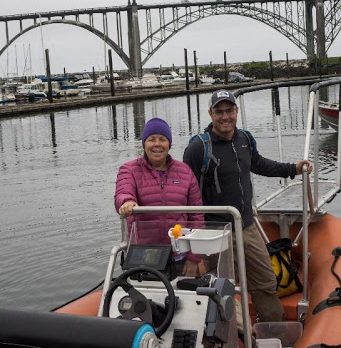
Once at sea and as we crossed the harbor jetty all eyes were overboard to spot a whale blow. Someone would shout, “there it blows!”- giving directions to the pilot on where to go. We imagined the boat as a clock, with the bow being the 12, the stern being 6, and so on. For example, a whale could be seen at “1 o’clock” 50 meters away, meaning about 30° to the starboard and 50 meters away. That method was particularly useful when flying the drone as the drone pilot would be looking at the control screen not able to see overboard. As the boat carefully approached the whale, the researcher would assess the whale’s behavior and would decide if they could continue to approach the whale or not. If the whale was feeding or staying stationary, the researchers would decide to stay nearby and collect the data. However, if the whale was traveling or swimming away from the boat they would leave the individual and start searching for the next one.
Once in the vicinity of the whales, tasks would be assigned to each member on board such as taking notes, photographing the whales for photo-identification, operating the drone, setting the calibration board (a board of a known length which allowed us to calculate the exact size of each pixel at various UAS altitudes and accurately measure whale lengths) and, of course piloting the boat.
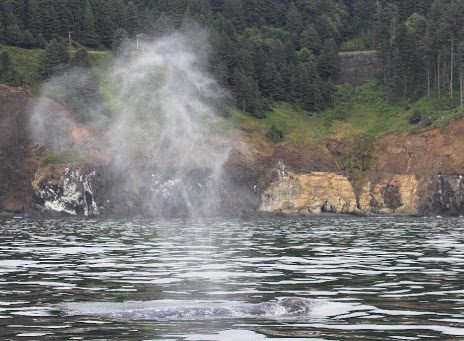
Whenever one of the researchers would scream “poop!” the boat pilot would hurriedly try to approach the location where the whale defecated at which point one crew member would use a net to collect as much fecal matter as possible. If the drone was flying, the pilot would keep following the whale with the aid of another crew member which would always be taking pictures of the whale. The frame number of the pictures would be written on the notes, synchronized with the time in the iPad frame that is linked to the drone, to match the ID of the whale with the sample collected. That was probably the most stressful moment aboard, where there were only a few seconds before the poop scattered and sank deep into the ocean. Collecting the precious samples was integral to our mission. In addition to the perilousness of collecting the fecal samples, it was also critical to accurately match the identity of the whale with the fecal sample and the drone images to complete the picture.
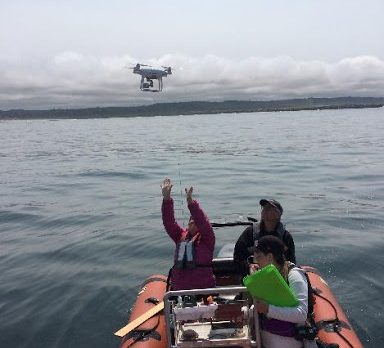
The gray whales looked prehistoric, especially when they would arch their back to submerge beneath the sea surface where if you were lucky, you could see a series of knuckles on their backs that resembled ancient dinosaur crests. As they dived, the ideal moment for photographing their flukes arose. Everyone was prepared to take the pictures that would help identify the individual whale, and oftentimes this was also the moment when the whales would defecate. These pictures would allow us to match the samples with the whale ID. However, unlike humpback whales where the photo ID is based mainly on the unique shapes and color patterns on the underside of their flukes, gray whales were complex in that the researchers needed more aids for individual identification. For every sighting we would try to take pictures from left and right, at the first knuckle, and the fluke whenever possible. With all this information, the scientists could identify the individual whales. But for the GEMM research team I worked with, it was apparent that they know most of the individual whales very well. They could remember who was who and what that particular whale was doing days before or even in the previous seasons. They nicknamed most of them and for many of the whales they even knew their gender and whether they came with a calf in the previous years. It was fascinating!
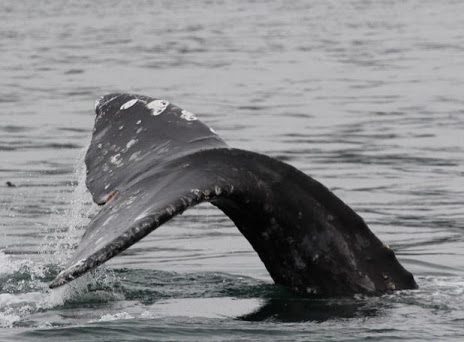
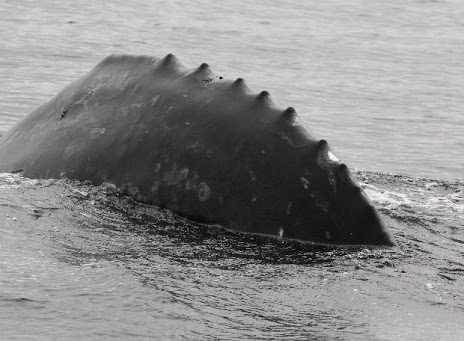
I myself had the opportunity to re-sight one particular whale. On my first day on the boat we spotted a whale who had a very distinctive heart shaped grey spot on the underside of her/his fluke and the very last day at sea we found that one again! It is hard to explain how amazing is to get the feeling of knowing an individual, wild and magnificent animal like these whales and I can only imagine the joy Leila, Leigh, Todd, and Sharon experience when they re-sight a whale from one season to the next after their long migrations! I nicknamed that whale, just for myself, as Pluto, because of the resemblance of the mark with the large heart-shaped nitrogen glacier revealed in 2015 on Pluto by the New Horizons spacecraft.
The days when we could not go out onto the sea, we were on “standby” for weather conditions to improve and get ready to launch the boat. Those were the times when I could interact with the rest of the GEMM Lab members. Dawn Barlow is a PhD student who studies the ecology of blue whales in New Zealand; Dominique Kone is a masters student working on a project that looks at the potential to reintroduce sea otters to the Oregon coast by identifying suitable habitat and investigating their potential ecological impacts. Leila Lemos is a PhD candidate leading the gray whale project. Prof. Sharon Nieukirk, an acoustics researcher, is helping to characterize the acoustic soundscape off the Oregon Coast. Unfortunately, I was unable to meet with the last member of the GEMM Lab, Alexa Kownacki, PhD student, as she was studying the common bottlenose dolphin’s population health off in California and is conducting fieldwork in San Diego, but we are all connected via email and are exchanging ideas on methods for studying hormones on free-living whale and dolphins.
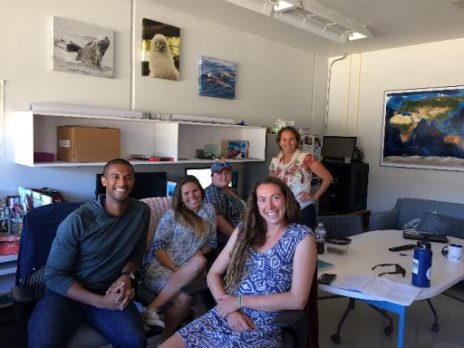
Friday, August 3rd, I presented my research plan to the GEMM lab, preliminary results and future goals, which led to a very interesting interaction with the lab members, where we exchanged ideas for plans in the future and ways to better understand the data I was generating. Additionally, we discussed the ongoing projects of the GEMM lab and again exchanged ideas. Building these new connections will greatly improve my opportunities to develop as a marine mammals’ scientist by broadening my views, learning about other projects and approaches to solve marine mammal ecology questions, as well as applying science to conservation of marine mammals and their habitats.
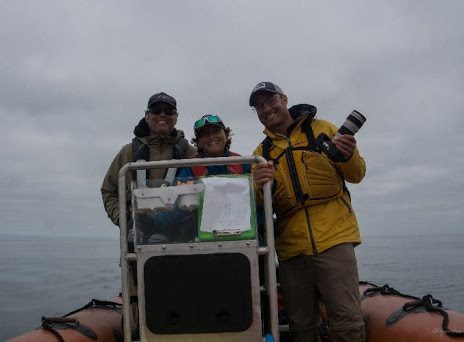
Furthermore, while I was at the HMSC, a humpback whale, Megaptera novaeangliae, was reported to be entangled in fishing gear off Winchester bay (76 miles South off of Newport). A rescue team from Cascadia Research, a non-profit Washington State corporation responded to the event and we were summoned to collaborate with the search of the entangled whale. Dr. Leigh Torres, Todd Chandler, and I met the group of Cascadia Research Collective (CRC) led by John Calambokidis. In total we were three boats at sea scouting the area and searching for this whale with gear. While looking for the whale we approached over 80 Humpbacks, and collected pictures for photo-identification that will contribute to the humpback whale photo-ID catalog in the North Pacific Ocean. However, despite over 8 hours at sea searching for the whale with gear, we were unable to find it and had to head back to shore with the gas tank almost empty but hearts full of wonderful memories and images of the whales, seabirds, and blue sharks that were swimming near the boat. The next day, we headed back to Newport to continue with the gray whale field work, but the Cascadia team continued the search in the following days. Hopefully, they will find and release the whale from the fishing gear.
I would highly recommend this type of laboratory exchange for building connections and networking with researchers in interdisciplinary fields of study who can synergistically collaborate in building new and novel science to solve both ecology and conservation questions. I would like to thank Dr. Leigh Torres, Leila Lemos and the GEMM Lab members for hosting me at the HMSC in Newport as well as Dr. C Loren Buck and Dr. Kathleen Hunt for encouraging me to participate in this exchange and the G2P2POP RCN for sponsoring this laboratory exchange.
